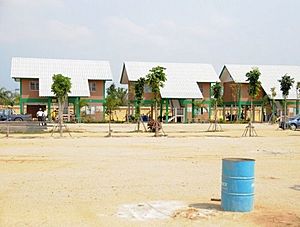Child protection facts for kids
Child protection means keeping children safe from harm. This includes protecting them from violence, being used unfairly, abuse, and not being cared for properly. It involves noticing signs that a child might be in danger. It also means helping children who have been hurt and making sure those who caused harm are held responsible.
The main goal of child protection is to make sure all children are safe and free from harm. It also tries to stop future harm. This is done by creating rules and systems that find and deal with risks before they become a problem.
Everyone has a part to play in keeping children safe. This includes individuals, groups, and governments. They must make sure children have a safe place to grow and learn. They also need to ensure children can get education, healthcare, and other basic needs.
Contents
Protecting Children
Most countries have laws to protect children and young people from certain dangers. For a long time, there was not much protection for children. Parents had the right to raise their children as they wished. Adults could also use physical punishment to make children obey.
But things started to change around the 1880s. In 1889, a law called the Children's Charter was passed. This law allowed the government to step in if children were being mistreated. It was the first time the state could get involved in how parents raised their children to prevent harm.
Today, Article 19 of the UN Convention on the Rights of the Child helps protect children both at home and outside. UNICEF describes a 'child protection system' as a set of rules and services. These services come from different areas like social welfare, education, health, and justice. They work together to prevent and respond to risks that could harm children. These systems also help families stay strong and reduce the risk of children being separated from their families, facing violence, or being used unfairly. Many different government groups, local helpers, and community groups share these responsibilities.
Challenges to Child Protection
Child Labor

Child labour is when children work, either part-time or full-time. This practice takes away a child's childhood. It can also hurt their physical and mental growth. Child labor is seen as a form of exploitation and is against the law in many countries.
Often, children are forced to work because their families are poor. This happens a lot in difficult and dangerous conditions. Such work can stop children from going to school. It also makes them more likely to be hurt by adults. It is hard to know exactly how many children work. In 2016, at least 152 million children under 5 years old were working. But this number is probably much higher because work done at home is not counted.
Parental Care
Parents have a legal duty to care for their children. This means providing food, a home, clothes, education, and medical care. It also includes giving emotional support. Parents must protect their children from harm and keep them safe. When a parent or caregiver fails to protect a child, it is called child abuse or neglect.
Child protection services often help families who are struggling. They try to keep families together so children can be safe and grow well. They also look into claims of child abuse. If needed, they can arrange for children to live with foster care families or be adopted.
Child Maltreatment
Child maltreatment means treating a child badly because they cannot defend themselves. This can include hitting a child, speaking harshly to them, not giving them food, or stopping them from going to school. This harm can be physical, social, or emotional.
Some caregivers treat children badly for different reasons. Sometimes it's because the child was adopted and then the caregiver had their own children. Some children are mistreated if they work as maids. Others might be hurt because of their skin color or because an adult is angry.
Other Situations Where Children Need Help
A survey in 2014 by the European Commission looked at child protection systems. It listed many types of children who might need help. These include:
- Children who are bullied or cyberbullied.
- Children caught in arguments between parents about who they live with. This includes when a parent takes a child away without permission.
- Children from minority groups, like Roma children.
- Children left behind by parents who move to another country for work.
- Children who are moving from one country to another.
- Children involved in court cases.
- Children who are poor or at risk of poverty.
- Children held by the police or in detention.
- Children whose parents are in prison.
- Children with disabilities.
- Children without parents or in other care arrangements.
- Children who are not in school or training, or who are working when they are too young.
- Missing children, such as runaways, abducted children, or unaccompanied children who disappear.
- Unaccompanied children who are moving from one country to another.
Important Child Protection Groups
- Free the Children
- Friends-International
- Mannerheim League for Child Welfare
- Odisha State Child Protection Society
- Save the Children
- War Child
- World Vision
- UNICEF
- TARA Homes for Children [fr]
See also

